
Table of Contents:
– Background
-Look and Feel
– Reticle Options and the PR2-MIL Reticle
– Comparative Optical Evaluation
– Mechanical Testing
– Summary and Conclusion
-Your Pro and Con Breakdown:
– Testing Methodology
Background:
Leupold is by far the largest U.S. optics manufacturer. They are so big that they are actually the second largest aluminum consumer on the west coast (behind Boeing). Leopold first released FFP Mil/Mil offerings in 2012-2013. These Mark 6 and Mark 8 product lines were both innovative and a bit outside the mainstream. At around that time I reviewed a number of these scopes, including the Mark 8 1.1-8x24mm CQBSS, Mark 6 1-6x20mm, and later Mark 6 3-18x44mm products. Among the uniqueness of Leupold’s Mark 6 and Mark 8 product lines, the two LPVO’s were the first scopes I encountered featuring phase diffraction illumination, and the Mark 6 3-18×44 was both smaller and lighter than virtually all of its competitors. The Mark 8 3.5-25×56 featured an uncommonly large erector ratio of 8x. The uniqueness of these product lines is an asset in many cases leaving them little or no direct competition to some models. However, it conversely left Leupold with no direct entry at a lot of popular price points and power ranges. In 2018, Leupold added the Mark 5HD line to fill a good bit of that gap. Generally lower in cost than the earlier front focal plane product lines, the Mark 5HD line is a direct competitor with the top product lines of Vortex, Bushnell, Burris, and others. Thus far it has been a successful line for Leupold and has already been expanded with the addition of a 7-35×56 model. The model I am reviewing here today, the 5-25x56mm PR2 Mil, is likewise a new model in that it features a new reticle offering for the 5-25x56mm platform. This reticle is the result of input from Leupold’s competitive shooters such as John Pynch, through whose podcast I expect most folks learned of it, and is designed specifically with an eye towards functionality in PRS type competition. The Mark 5HD product line has seen a good deal of success in this type of competition, with the number of competitors using it steadily rising year over year to the point that it is now one of the most popular optics in use.
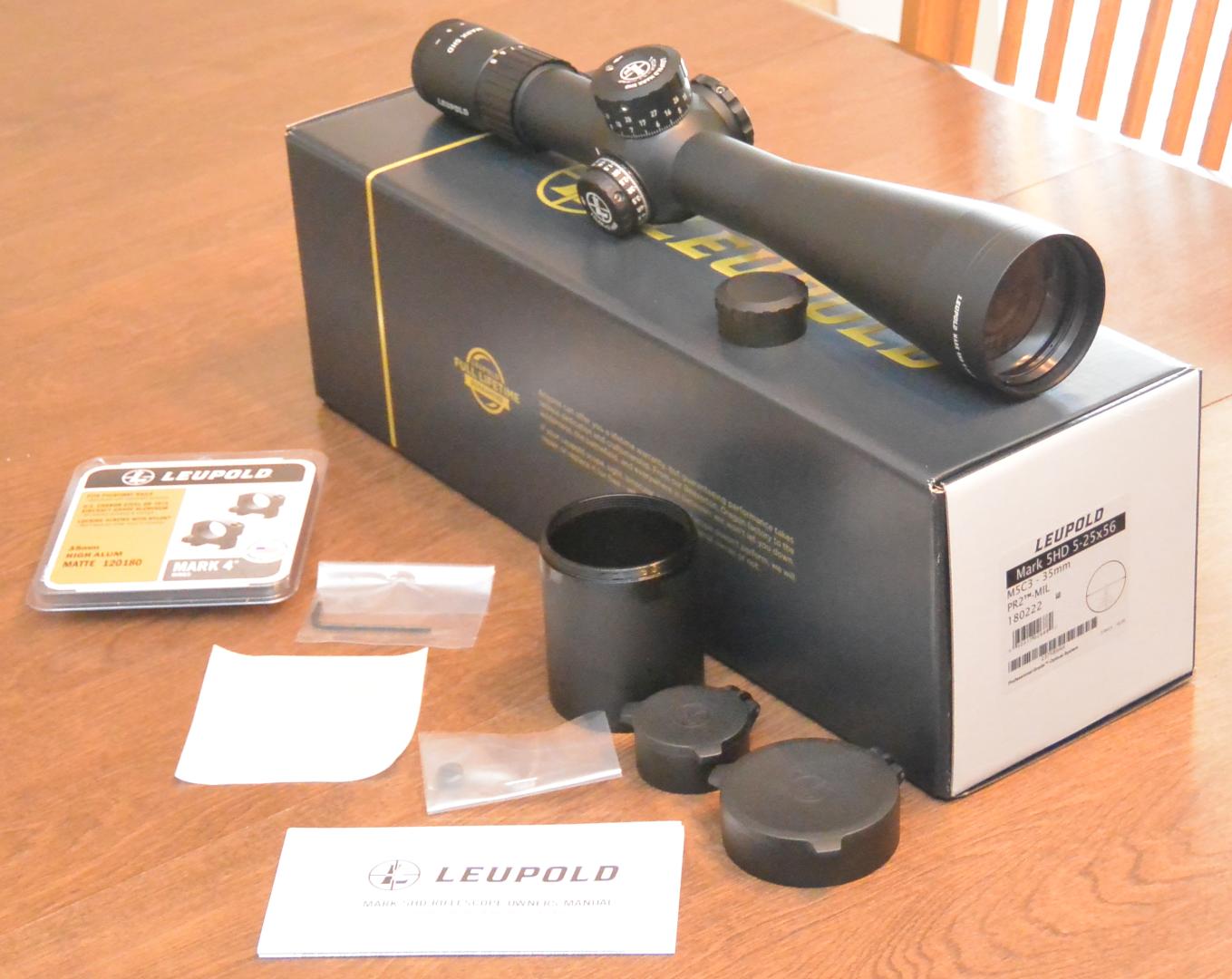
Look and Feel:
The most notable difference between the Mark 5HD and the scopes it typically competes with in practical rifle competitions is how much better suited the Mark 5 is for hunting applications. At 30oz, it is substantially lighter than the 35-45oz typical for long range mil/mil FFP scopes in its price range. It also sports a lower profile, non rising, locking elevation turret with turn indicator and an even lower profile capped windage turret. Leupold calls this elevation turret the M5C3. The turret design was originally made as a secondary, lower profile option for the Mark 6 3-18×44. That option ended up being massively more popular than the original M5B2 and so was adopted, with an extra turn of travel, wholesale for the Mark 5HD line. The design locks only at zero and contains turn indicators for both turns beyond that point.
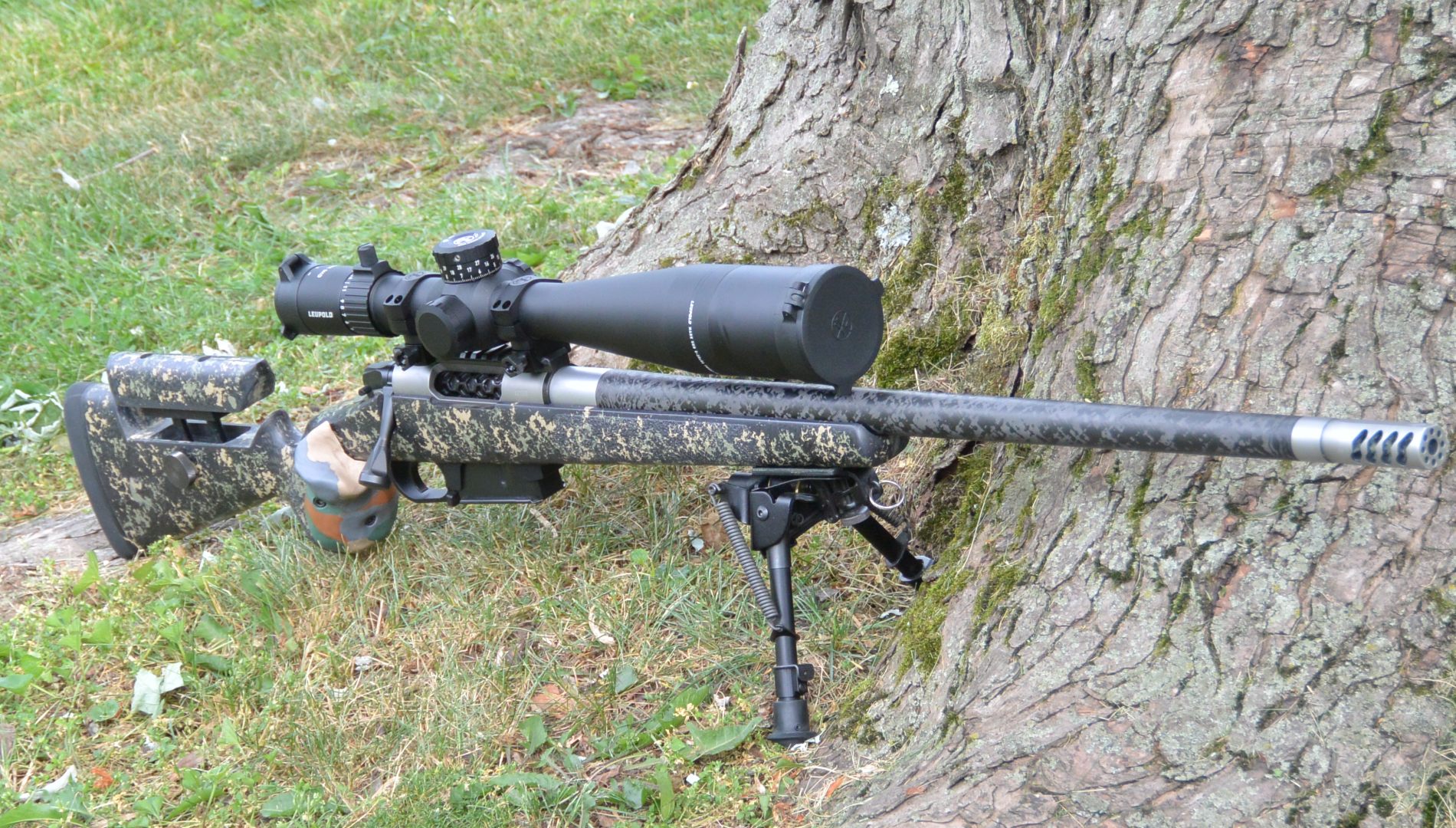
Leupold lists the Mark 5HD 5-25×56 as having 35mil for travel in its elevation. This is doubly incorrect. The elevation knob will go just 3 turns at 10mils / turn for 30mils exactly from the zero stop and has just .5mil below the stop, so, in use, you do not get 35 mils. In case you are thinking that total internal travel is 35 mils, that is also not correct. I measured 43.7 mils of total internal travel, so no part of its travel is 35mils. However, you are very likely to get the full 30 mils of travel on the elevation knob as its massive internal travel gives you a little leeway as far as canted bases go. Though the elevation knob is listed at 10 mils per turn and does go to exactly 30 mils in three turns, unusually, it is actually 10.5 mils per turn. This results in the markings for the second turn being offset from the first one by .5 mils and the 3rd turn another .5 mils. As such, 2 mils on the first turn aligns with 12.5 on the second turn and 23 on the third. I expect one gets used to this, but so far I have found it a little unbalancing and it takes me longer to make adjustments than normal because I end up double checking whether particular index lines are mil lines or half mil lines. The elevation click feel is on the squishy side with very loud, but not particularly tactile clicks. Nevertheless, the force required to rotate is fairly low and it is easy to make just one click at a time and not lose count. The windage feel is a little more tactile and is also well-calibrated to prevent count loss. Zeros on both elevation and windage knobs set quite easily and in the most common way with two set screws on the elevation and three on the windage. Interestingly, the windage index line has been moved up from center on the knob to offset it from the rings, presuming you are using horizontally split rings.

As is common on Leupold scopes, the Mark 5HD 5-25×56 is available both with and without illumination: and the illumination does not come cheap at ~$500 extra. Since I have yet to actually use illumination on a high power scope, I would suggest saving the dough. The side focus parallax on the HD5 is a bit on the soft side in terms of feel. It is rated to 50yds close focus distance, though it quite frankly does a lot better than that and should be passable, though not ideal, for .22lr use. The diopter is of the fast focus euro type and is stiff enough it shouldn’t inadvertently move. The power ring on the HD5 includes both a small integral lever and a much larger one that can removed and replaced with a plug if you so desire. The extras in the box for the HD5 include both flip caps and a sunshade, so you are really ready to rock and roll right out of the box. Don’t forget that the rings required for the HD5 are the unusual 35mm size. I would have, but Leupold, having probably already encountered the problem before with other optics writers, sent along a set of aluminum Mark 4’s.
Reticle Options and the PR2-MIL Reticle:
The Mark 5HD 5-25×56 is available in more reticles than probably any other scope offered by anyone. There are a total of eight different options, including two Horus, two MOA, and four non-Horus mil options. Basically, whatever common reticle type you could want they have at least one, and maybe two, of.
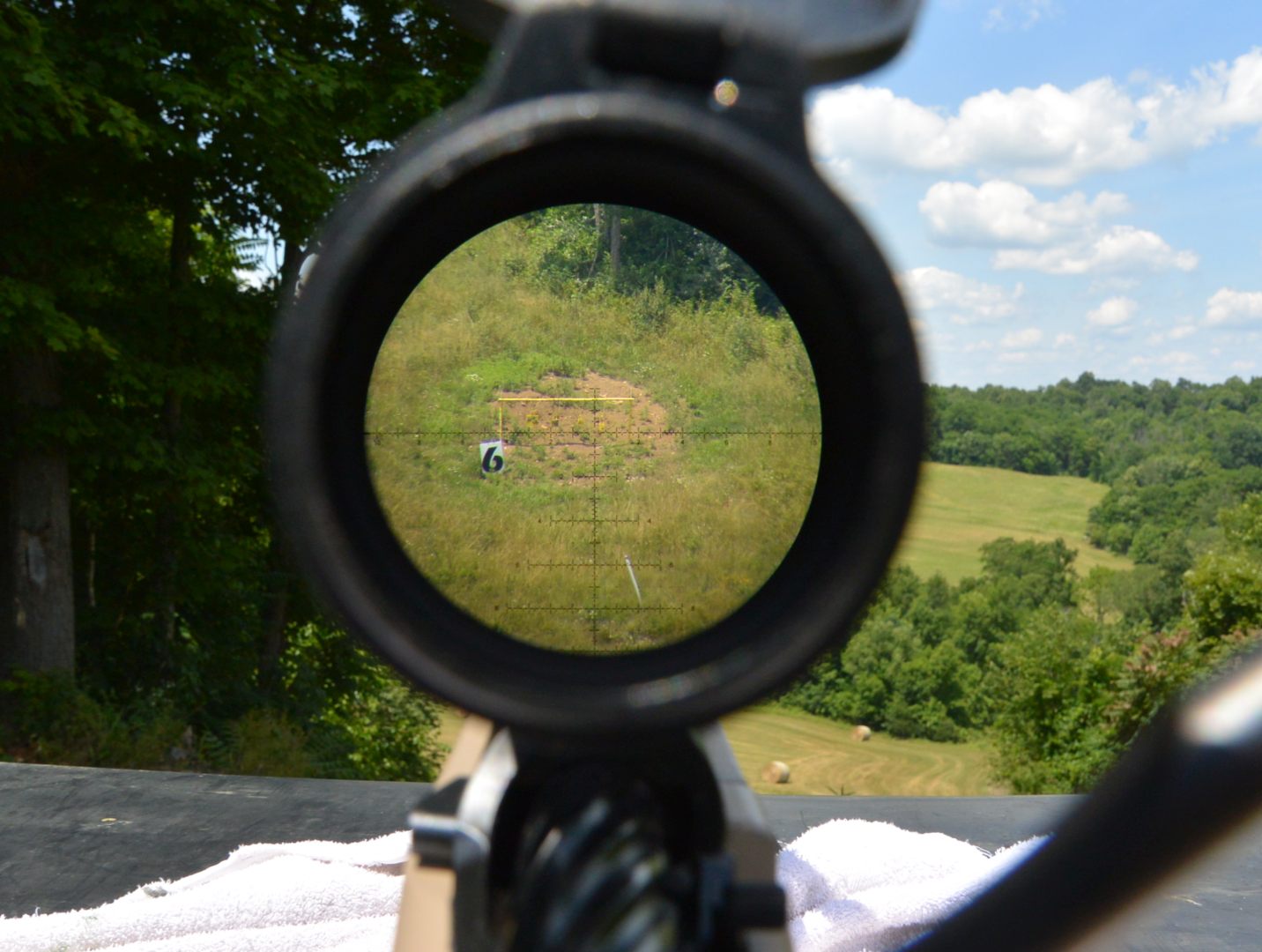
For my review, I chose Leupold’s latest reticle design, the PR2-MIL. This design is the result of a collaboration between a number of Leupold’s top competitive shooters, including John Pynch, Dan Bertocchini, and Doug Koenig. I think this is a great concept that more scope makers should employ when designing their competition focused reticles. Often, scope makers simply aim to copy the basic look of others’ successful reticles and end up messing it up because the guy doing the translation doesn’t really understand which elements of the reticle to be emulated were the most important and how each element interacts with the others to form a cohesive whole. The result is often a reticle which has relatively unimportant aspects straight up copied with important stuff haphazardly changed for the worse. Having people who are successful examples of your intended audience actually design the reticle is a good way to make sure it works, at the very least, and may even get you some design innovation as a bonus. You should keep this reticle’s pedigree in mind when reading my opinions as these guys are, frankly, a lot better and more knowledgeable shooters than I am.
On the most basic level, the PR2-MIL reticle has many of the most common elements found in long range reticles today. It is a mil Christmas tree reticle with floating dot center and what I would call medium line thickness. Like many of the newest designs, the PR2 next removes all but 2mils of the 12 o’clock post. It also slims down the lines every other mil on the Christmas tree portion to just very small dots every half mil. Both on the windage and elevation markings, the PR2 goes out a little further than most scopes, with 10 mils fully marked each way in windage and 32 mils total in elevation (though the Christmas tree stops at 10). The PR2 finally departs some from the most common reticle patterns in being graduated in .25 mil increments for most of the reticle and having a tiny gap at the intersection of those markings with the main crosshair.
The parts I like best about the PR2’s design are the open 12 o’clock and fully graduated 6 o’clock. I’m a big fan of open 12 o’clock reticles as I think you get more out of having some unobstructed space than you do having another section you can use for measurements, since you never realistically hold under a significant distance. The 12 o’clock area is a particularly good place to have that open space as you need all the help you can get when it comes to trying to observe trace. I ended up liking the fully graduated 6 o’clock for two reasons. The first of these was a bit unexpected: the graduations made for a lack of a thick post at 6 o’clock and I found this accentuated the thick posts at 3 and 9, sort of making a horizon effect at lower powers. I’m not sure if this actually helped me to be more level in practice since it all disappeared when I dialed to the power I shoot most targets at, but I liked the effect at low powers. And if you start observing your target at lower power when locating it in the scope, you may find that this horizon helps with keeping things level even at higher power as you may retain a feel for the lay of the land around the target. Conceptually, I also like the idea of having graduations for more potential drop. In practice, I expect that really only the ELR guys might ever get to the point of exhausting their elevation knob and still needing a ton of drop compensation, but I’m drawn to the ‘why not’ of it even though in practice I did not exhaust the substantial elevation travel of the Mark 5HD at any point in testing.
Without question, the trickiest part of the PR2-MIL reticle is the .25mil graduation scheme. Reviewing as many scopes as I do, I use a lot if different reticles with different graduation schemes on a pretty regular basis. For whatever reason, I have found these .25mils to be more difficult than most other mil schemes to adjust to. I thought it would be quite similar to shooting one of the various .5mil graduated scopes that I have used, but it didn’t seem that way in practice. Be prepared for some adjustment. I remember John mentioning the adjustment period on his podcast and, sure enough, it was more than I expected. In the end, he said he has grown to prefer having less graduations with the .25 mil divisions. For my part, I have come to realize that I basically think in tenths of a mil and slightly more thought seems to be required to mesh this with .25 mil graduations than with .2mil or .5mil.
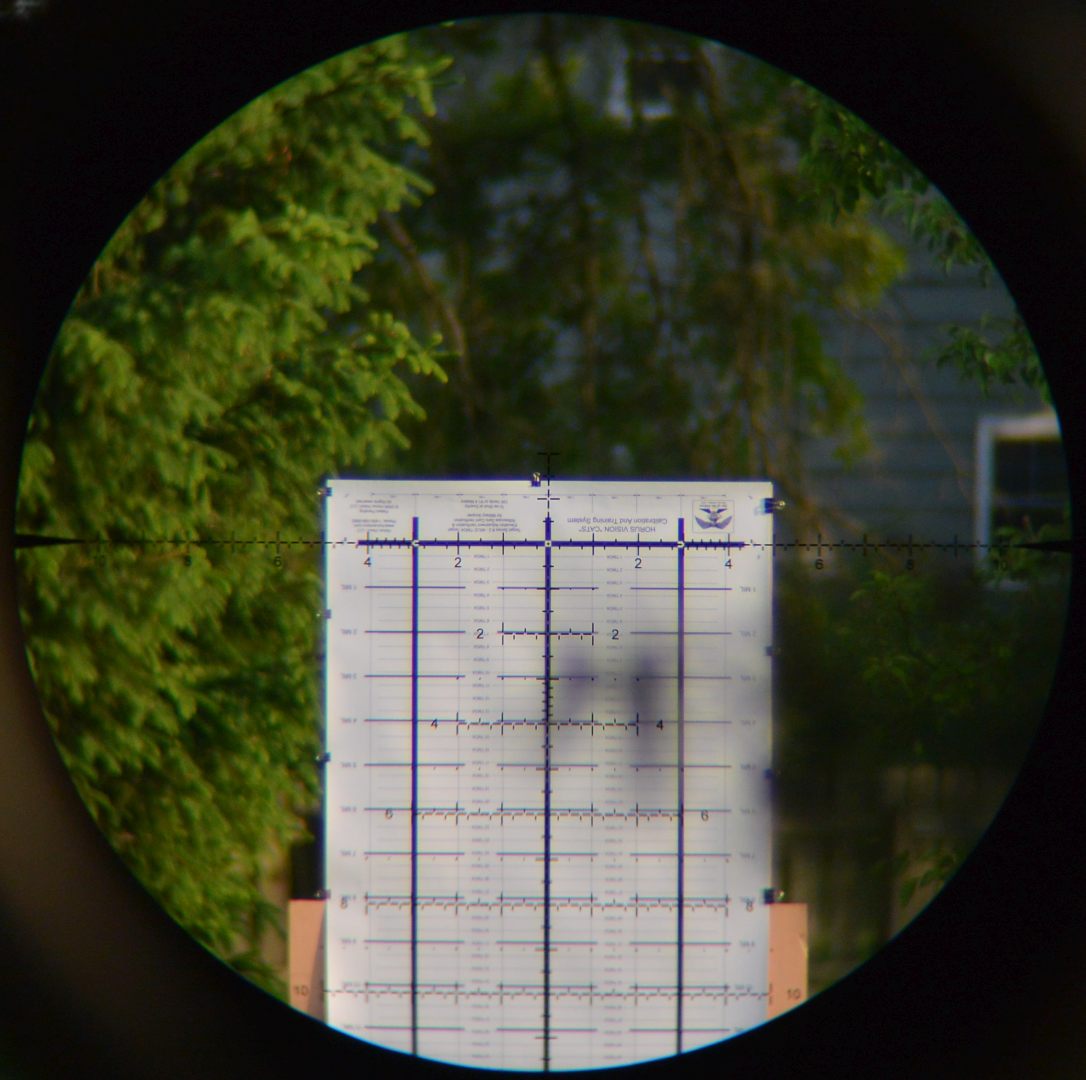
The reticle in my test scope had no cant, though, like the adjustments, it was 2% too large.
Comparative Optical Evaluation:
For optical comparison with the Leupold Mark 5HD 5-25×56, I first have two other scopes in this year’s series of ~$2k long range scope reviews: the Minox 5-25×56 LR and Sig Tango6 5-30×56. As per usual, I also pulled an example of both a significantly more costly and a less costly optic. For these I used an Athlon Midas TAC 5-25x56mm, one of the better performing from my series of sub $1k optics, and the much more costly Zero Compromise Optics ZC420 reviewed last year. I also had a Minox ZP5 5-25×56 on hand and found that comparison interesting as well. Later this year I expect to be reviewing a Bushnell Elite Tactical of similar cost and may post an update to this section reflecting that comparison at that time if such proves interesting.
As should be expected, but is not always the case, the optical performance of the scopes compared during this review did break down into the respective price brackets. All of the ~$2k scopes generally outperformed the ~$1k scope, and the $3k+ scopes out-performed all the ~$2k scopes. Within the $2k scope bracket, the Sig generally underperformed its rivals, whereas the Leupold and Minox are difficult to rank against each other in a linear manner as their relative optical strengths and weaknesses differed greatly.
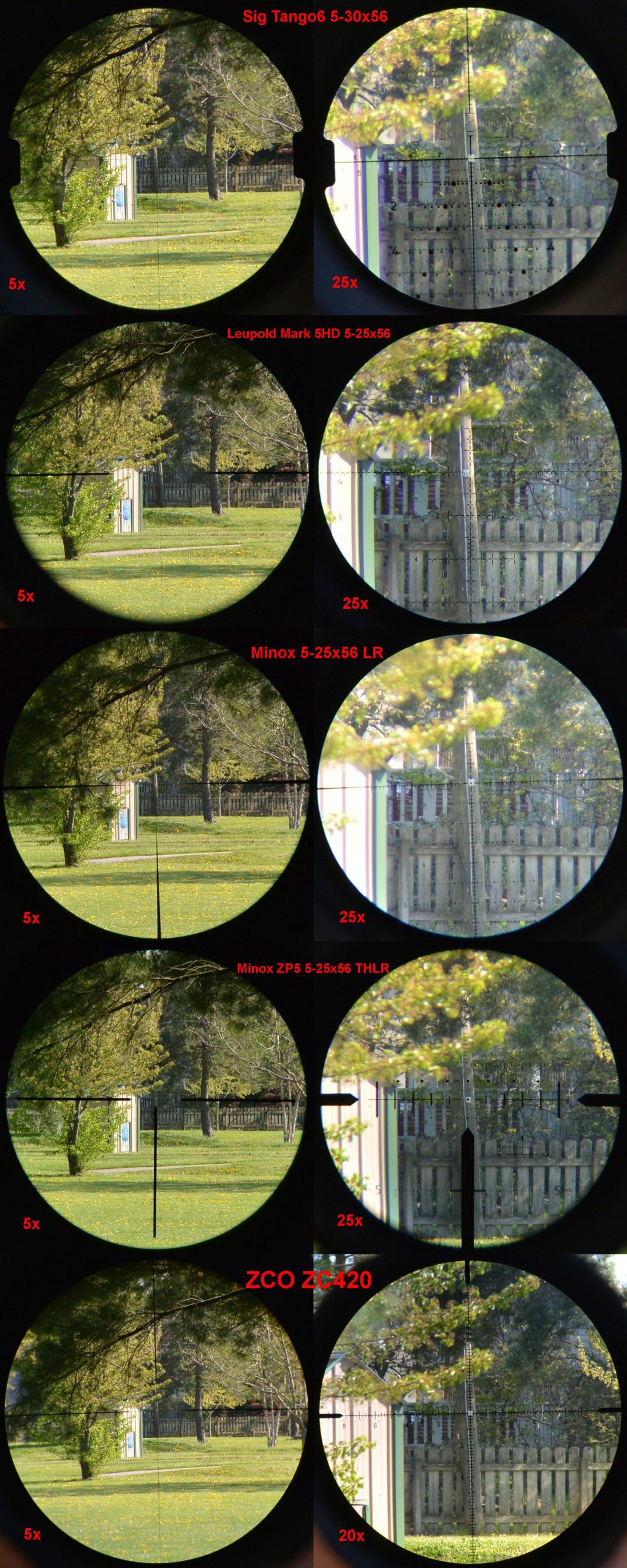
The weakest areas of performance for the Leupold Mark 5HD 5-25×56 were low light performance, field of view, contrast, and edge to edge clarity. It performed below all the other $2k and $3k optics in low light and edge to edge clarity while only outperforming the Sig in field of view. Realistically, the low light performance is a pretty minor concern, as differences are generally not that great between optics of similar magnification and objective size. Coatings are quite good nowadays, so transmission differences are fundamentally small. The field of view and edge-to-edge clarity performance is of much greater relative import. Between not having a particularly large FoV to start with and that view deteriorating more on the edges than most, this is Leupold’s largest optical liability. As for contrast, I did find the Leupold to have greater difficulty than the other $2k and $3k scopes making out fine details in shadow, but overall differences were small across the whole range of optics tested and so not a big concern.
Areas where the Leupold was average in performance relative to its price peers were color rendition, eyebox, resolution, stray light handling, and chromatic aberration. Grouping these measurements together is a bit misleading, as I feel the objective performance on some measurements was excellent whereas others were average. The Leupold’s color rendition, for instance, was both average for the group it was compared with and average generally. It had a noticeable slight green tinge. Not great, but also not a problem. Sort of an OK, nothing to note here, move along, impression. The same was true with eyebox and stray light handling (sunshade not on). Resolution and chromatic aberration left me with a very different impression. The Leupold may have been average within the test group but its performance was quite good in a larger sense. We’re talking almost no chromatic aberration and its resolution quite close to the $3k scopes. Really excellent performances even if the Minox LR was likewise so and the Sig turned in excellent resolution though only so-so CA.
Leupold’s best area of optical performance is depth of field. I expect this was a deliberate design choice. DoF is of great importance for timed competitions since competitors often do not have time to change the scope’s parallax during a stage that has targets at several different distances, or they are simply prohibited from doing so by a particular stage’s rules. Virtually all such competitions also require shooters to spot their own shots, so larger DoF gains an advantage though a better chance of seeing trace in such cases. If you were to design a scope for PRS type competition, DoF might land near the top of your list of optical criterion to maximize whereas for traditional paper competitions it was certainly last and is only of moderate importance in hunting designs. Leupold was certainly thinking about the PRS community when designing the Mark5 HD and it shows. The Mark 5HD had tremendously more DoF than its price competitors and I felt it ran neck and neck with the Minox ZP5, a much more expensive scope well known for having excellent DoF. Only the ZCO had noticeably more. A side effect of the Mark5 HD 5-25×56’s excellent DoF coupled with its substantial eyebox is that it is easier to introduce parallax error on the Mark5 without noticing than it is on most scopes. I encountered this effect when testing the adjustments on the Mark 5. On any scope, when you move the adjustments further and further from center, you actually end up having to move the parallax setting as well, since it changes. This is something you would never notice when shooting as you would always have to adjust the parallax when moving the adjustments anyway since you do both to shoot at different distances. You notice it when testing adjustments with a test target though because the distance is not changing and you are moving adjustments a lot, as far as they will go in fact. On the Mark 5HD, I would notice that refocusing the parallax after adjusting the elevation made my aim point move. This is not something I have seen before and at first I thought I might have a strange new issue. It didn’t feel like I was moving my head or that it was off center. I ran some more tests and found I was the problem. I simply was not centered enough behind the scope. This was simply easier to do on the Mark5 and harder to notice, probably as a function of a generous eyebox coupled with excellent DoF. These are both good things, but beware the user error you can easily induce and that it is a bit harder to tell you have done it.
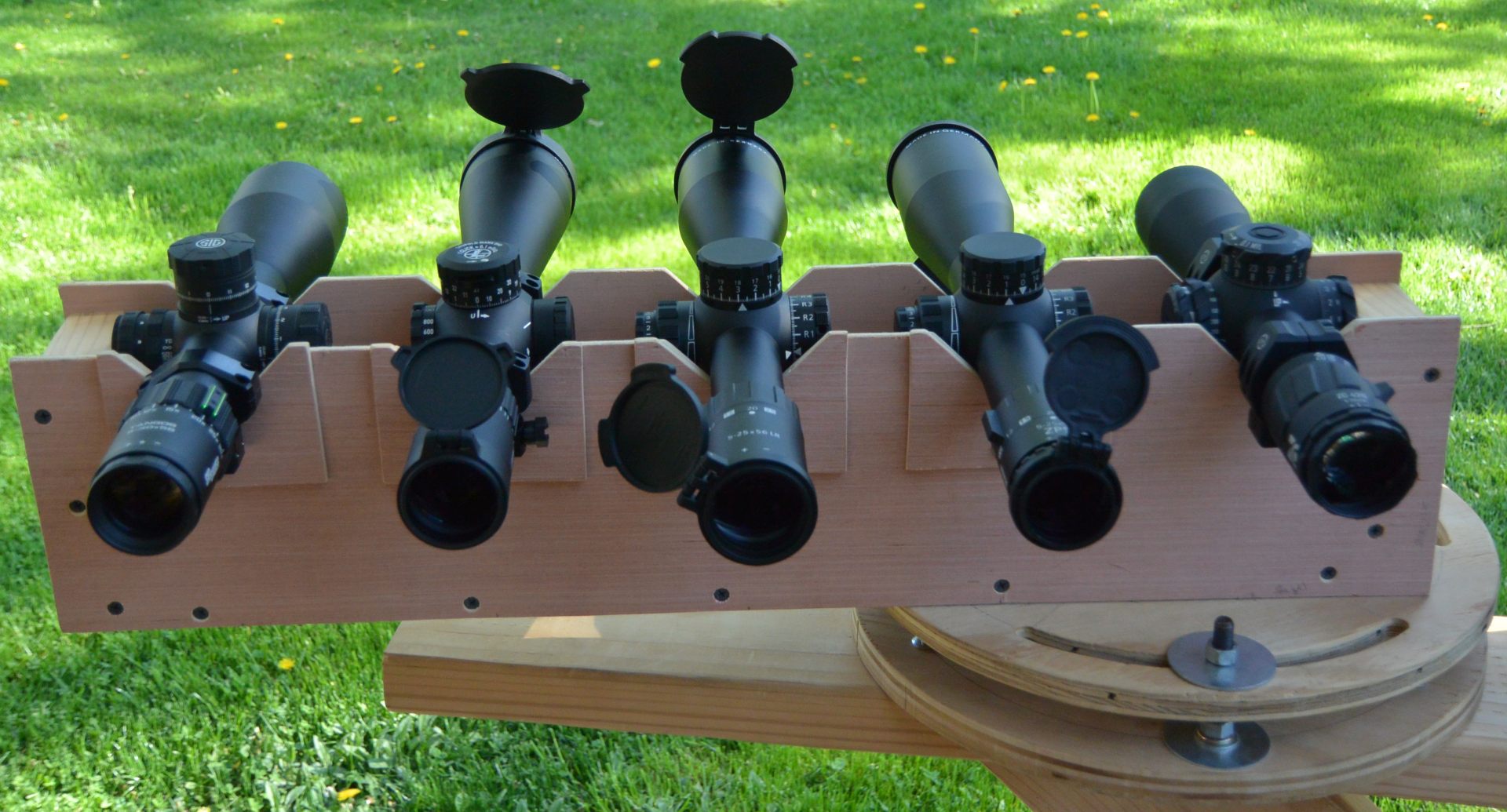
Mechanical Testing:
Most scopes have some deviation from perfect adjustment magnitude though they are doing far better now than just a few years ago. This adjustment magnitude error will vary from example to example within the same model of scope. This is because it is not a product of design errors, but rather variances introduced within manufacturing and, particularly, the assembly. So, the performance of my test samples is a piece of information with only limited value due to representing only one example. Often, we measure adjustment magnitude error as a % such that a scope whose reticle moves 10.1 mils when adjusted 10.0 mils tracks at 101% and one who’s reticle moves 9.9 mils when 10.0 is dialed tracks at 99%. Frank has helpfully compiled a list of adjustment deviation of all scopes he has tested in class that can give you an idea of how often, and by how much, adjustment magnitude deviates from ideal. As the Mark 5HD has been around a few years and is a popular design, quite a few examples have been tested and recorded with what I will call mixed results.
When adjusting up from zero, the Leupold Mark 5HD 5-25×56 I tested read 10.2 mil on target when adjusted 10.0 mils on the knob and 15.3 mil on target with the knobs at 15.0. It maxed out in the up direction at a massive 21.7 mils on target and 21.4 mils on the knobs. This equates to 102% on Frank’s scale and represents a 2% deviation from ideal. Adjusting down from optical zero, the Mark 5HD read 10.2 mils on the target at 10.0 mils on the turret and it goes to 22.8 mils on the target and 22.3 on the turret. It’s a pity Leupold didn’t add a fourth turn in the elevation knob, as the scope has over 13 mils more internal adjustment than can be accessed. It easily could have serviced another 10 mil revolution. At full elevation range, windage adjustments worked fine out the 5 mils each way they can travel to with no indication of maintube / erector interference. As with the 2% deviation on adjustment magnitude, the Leupold showed the same 2% deviation in reticle size with 10.0 mils on the target being 9.8 mils on the reticle. In my experience, this is a fairly large deviation for a reticle to show.
Because of the non-rising nature of both the elevation and windage knobs I checked for slop in the spline necessary for this feature. This has been an issue on other designs and can result in being as much as a full .1 mil difference in reticle position on the target at the same position on the adjustment knob depending on whether the shooter adjusted up to the number or down to it. The Mark 5HD showed only a very small amount of slop roughly .01 or .02 mils. This is certainly well within acceptable, and negligible, range. Similarly testing clean, the reticle showed no cant and point of aim did not shift when the power or parallax was changed.
The reticle in my test Mark 5HD 5-25×56 had negligible cant but, as with the adjustments, measured too large by 2%.
Summary and Conclusion:
Though Leupold’s Mark 5HD line is certainly more mainstream in both price and features than its Mark 8 and Mark 6 lines it is still substantially different enough from its competitors too give it some unique advantages. Though marketed as a “tactical” and competition scope, it is well suited to hunting use, too. This is not true of most of its competitors and is due to the Mark 5HD’s relatively lighter 30oz weight, smaller stature, locking elevation turret, and capped windage turret. The Mark 5HD 5-25×56 even features an integrated but removable throw lever giving both competitive shooters and hunters what they want. Further highlighting this ‘everything for everyone’ design focus is the variety of both mil and MOA reticles and availability in both illuminated and non-illuminated configurations, leading to 12 total SKU’s for the 5-25×56 Mark 5HD model. Versatility is perhaps the greatest virtue of the Mark 5HD product line.
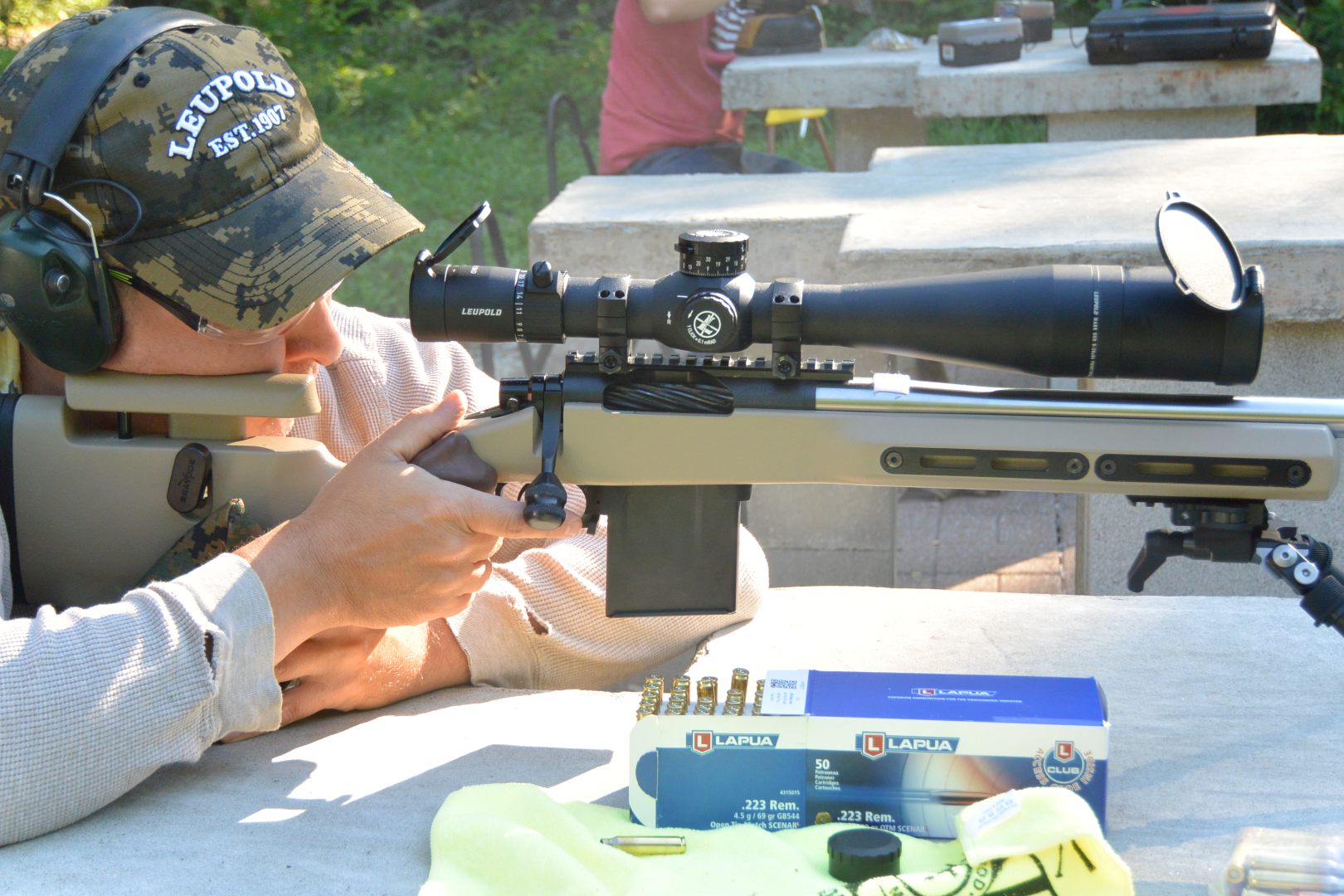
In keeping with the theme of versatility, the M5C3 elevation turret on the Mark 5HD line is really quite the wonder of functionality. Despite being smaller than most competing designs, it packs in a zero stop, zero lock, and 2nd and 3rd turn indicators: a simple and highly functional system.
I am pleased with Leupold’s decision to include their sponsored shooters in the design of some of their reticles, the new PR2-MIL reticle examined in this review being one of these. This practice is not new for Leupold, as they have long produced the DTR reticle scopes for David Tubb. I found the general layout and features of the PR2-MIL reticle well considered and functional in use, though I find the .25mil graduations to require a bit more thinking for me than either the .5mil or .2mil schemes more common in the industry.
Optically, the Mark 5HD 5-25×56’s overall performance was quite good. It excelled particularly in depth of field, resolution, and chromatic aberration, while it was lacking in field of view and edge to edge clarity. On balance, I think the Mark 5HD 5-25×56 is optically better than generally should be expected at its cost. Given that optical performance coupled with the aforementioned advantages in weight and features, it is unsurprising that the Mark 5HD 5-25×56 has proven such a successful product for Leupold.
Your Pro and Con Breakdown:
Pros:
– Lighter than most competing scopes at 30oz
– Highly functional M5C3 knob include zero stop, zero lock, and 2nd and 3rd turn indicators in a fairly compact package
– Excellent competition / hunting crossover functionality
– 8 total reticle choices including the new, team shooter designed PR2-MIL
– Better than class average optical performance with particularly good depth of field
– Comes with both sunshade and flip caps
– Excellent warranty and support
Cons:
– Illumination is a costly option to add
– Field of view is on the small side with not great edge-to-edge performance
– Numbers being staggered by .5mil per rev on the elevation turret takes some getting used to, as do the .25mil graduations on the PR2-MIL reticle

